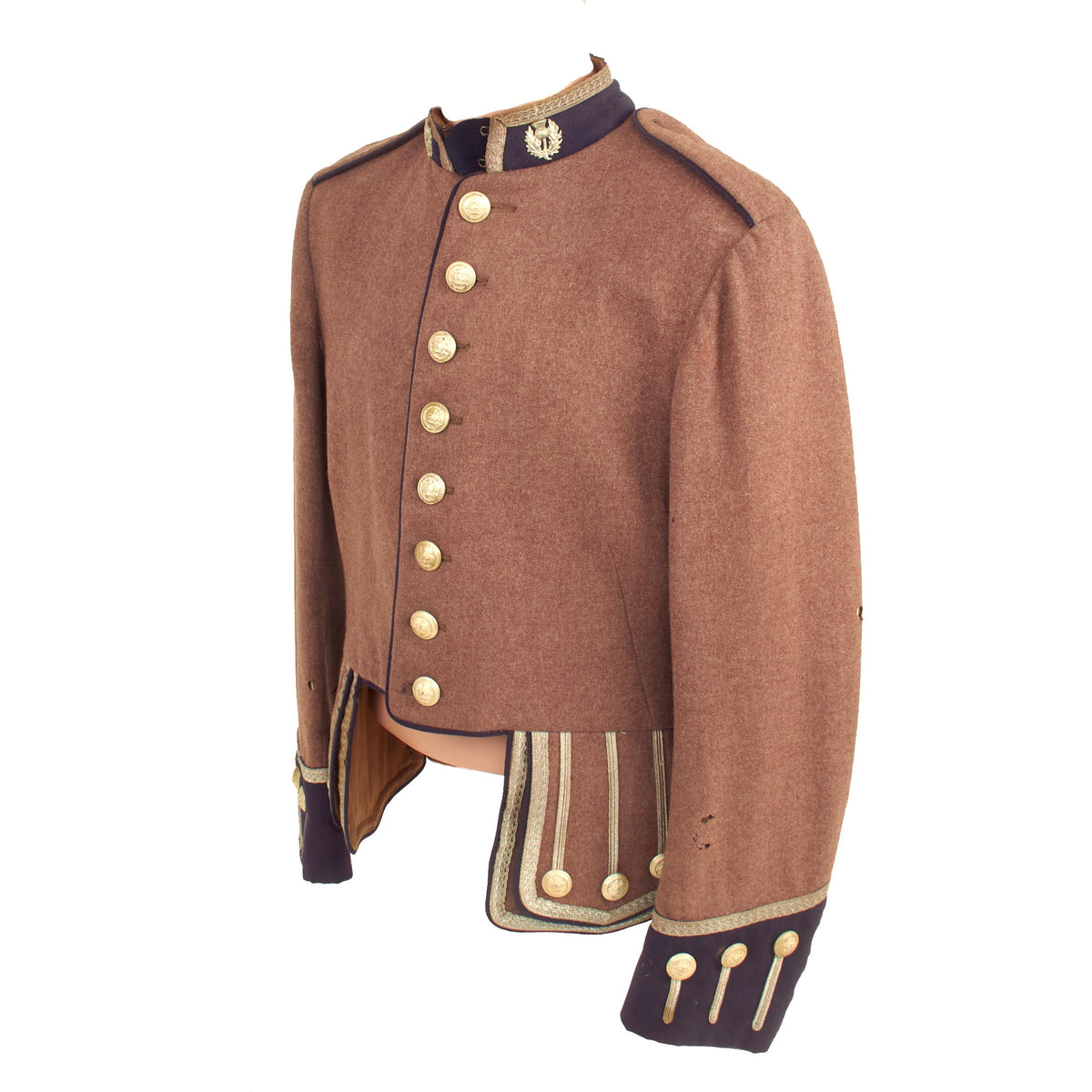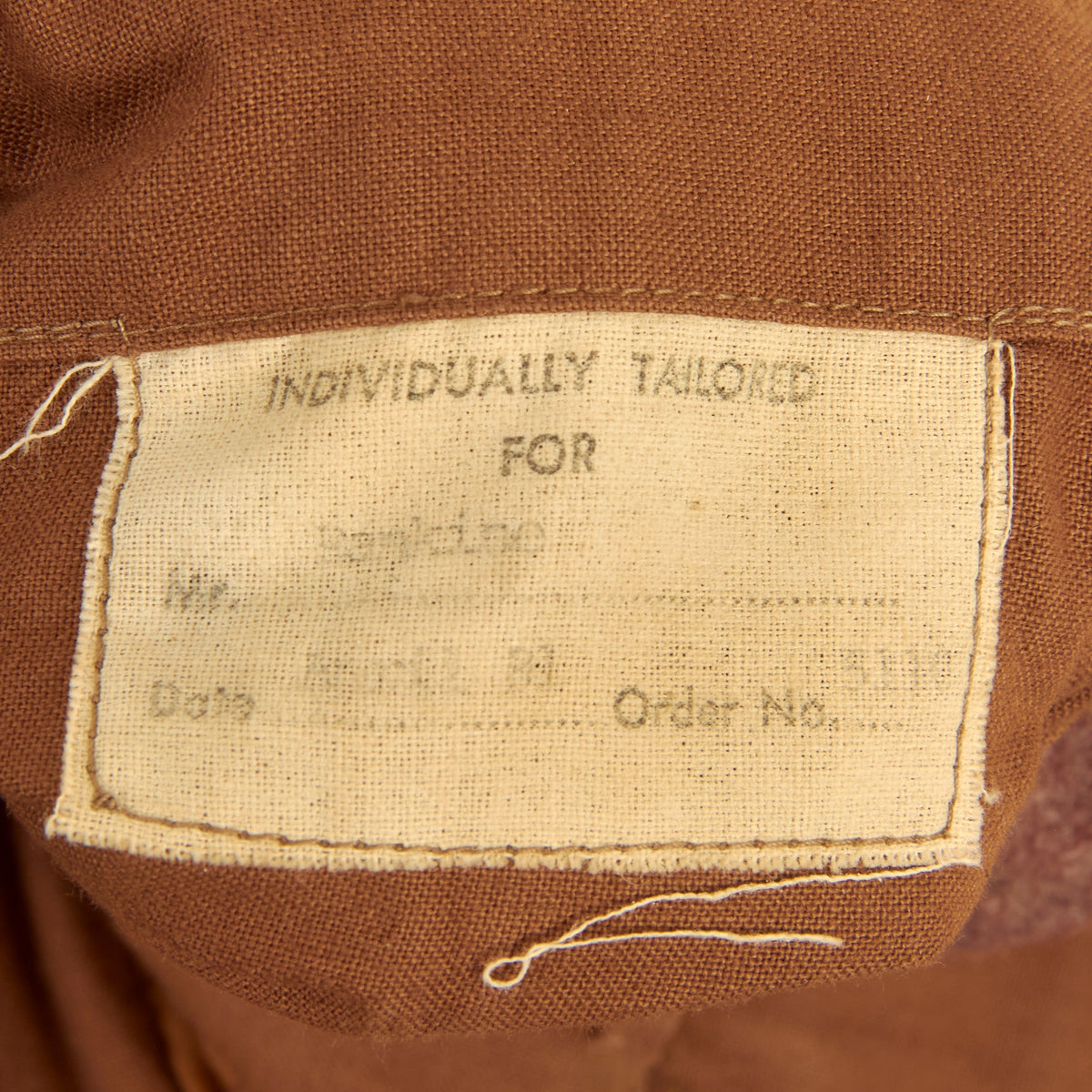Original British WWI 9th (Scottish) Infantry Division Dress Doublet; London Scottish Volunteers Original Items
$ 295,00 $ 118,00
Original Item: Only One Available. This is a very nice WWI era London Scottish Volunteers Doublet. This full dress uniform tunic has 8 silvered buttons with the London Scottish coat of arms down the front. Other notable features are epaulets with pinned insignia, stand up bullion trimmed blue collar with white piping. The interior is fully lined in a rather heavy cotton/wool material.
A doublet is a man’s snug-fitting jacket that is shaped and fitted to the man’s body. The garment was worn in Spain, and spread to the rest of Western Europe, from the late Middle Ages up to the mid-17th century. The doublet was hip length or waist length and worn over the shirt or drawers. Until the end of the 15th century, the doublet was usually worn under another layer of clothing such as a gown, mantle, overtunic or jerkin when in public.
Throughout the 300 years of its use, the doublet served the same purpose: to give fashionable shape and padding to the body, to support the hose by providing ties, and to provide warmth to the body. The only things that changed about the doublet over its history was its style and cut, as you can see from this example here.
This doublet was worn by a member of the 9th (Scottish) Infantry Division and is identified by the embroidered epaulets.
The uniform doublet is in overall wonderful condition but there are the expected scattered moth nips, slight thread separation and staining.
A great example that comes more than ready for further research and display.
The 9th (Scottish) Division, was an infantry division of the British Army during the First World War, one of the Kitchener’s Army divisions raised from volunteers by Lord Kitchener to serve on the Western Front during the First World War.
After the 1st South African Infantry Brigade Group joined in early 1916, the division was known colloquially as the Jock and Springboks.
In the Battle of Loos, notable for being the first battle in which British forces used poison gas, the 9th (Scottish) Division assaulted the Hohenzollern Redoubt, the 5th Camerons suffered horrific casualties, and Corporal James Dalgleish Pollock gained a Victoria Cross for his actions.
The 9th (Scottish) Division took part in major fighting during the Somme offensive. Notably it relieved the 30th Division at Montauban and later attacked German positions at Bernafay Wood, where it succeeded in capturing vital objectives and forcing a German withdrawal. In the Somme offensive, the 9th (Scottish) Division liberated the village of Longueval; the village now has a statue of a Scottish piper at its crossroads that commemorates this fact (see Caterpillar Valley Cemetery) and also other pipers who served in the First World War.
Approximate Measurements:
Collar to shoulder: 9.5″
Shoulder to sleeve: 27.5”
Shoulder to shoulder: 17”
Chest width: 19.5″
Waist width: 17.5″
Hip width: 21
Front length: 20.5″
Fast Shipping with Professional Packaging
Thanks to our longstanding association with UPS FedEx DHL, and other major international carriers, we are able to provide a range of shipping options. Our warehouse staff is expertly trained and will wrap your products according to our exact and precise specifications. Prior to shipping, your goods will be thoroughly examined and securely secured. We ship to thousands clients each day across multiple countries. This shows how we're dedicated to be the largest retailer on the internet. Warehouses and distribution centres can be located throughout Europe as well as the USA.
Note: Orders with more than one item will be assigned a processing date depending on the item.
Before shipping before shipping, we'll conduct a thorough inspection of the items you have ordered. Today, the majority of orders will be delivered within 48 hours. The delivery time will be between 3-7 days.
Returns
The stock is dynamic and we cannot completely manage it because multiple stakeholders are involved, including our factory and warehouse. So the actual stock may alter at any time. It's possible that you may not receive your order once the order has been made.
Our policy is valid for a period of 30 days. If you don't receive the product within 30 days, we are not able to issue a refund or an exchange.
You can only return an item if it is unused and in the same state as the day you received it. You must have the item in its original packaging.
Related products
Uncategorized
Uncategorized
Uncategorized
Uncategorized
Uncategorized
Uncategorized
Uncategorized
Uncategorized
Uncategorized
Angolan Rebel 1970s era 60mm Inert Display Mortar from Angolan Civil War Original Items
Uncategorized
Uncategorized
Uncategorized
Uncategorized
Uncategorized
Uncategorized
Uncategorized
Uncategorized
Uncategorized
Uncategorized
Uncategorized
Armored Burgonet Helmet & Polearm from Scottish Castle Leith Hall Circa 1700 Original Items
Uncategorized
Uncategorized
Uncategorized
Band of Brothers ORIGINAL GERMAN WWII Le. F.H. 18 10.5cm ARTILLERY PIECE Original Items
Uncategorized













































































